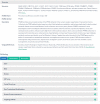Nuclear Receptor Signaling Atlas: Opening Access to the Biology of Nuclear Receptor Signaling Pathways
- PMID: 26325041
- PMCID: PMC4556694
- DOI: 10.1371/journal.pone.0135615
Nuclear Receptor Signaling Atlas: Opening Access to the Biology of Nuclear Receptor Signaling Pathways
Abstract
Signaling pathways involving nuclear receptors (NRs), their ligands and coregulators, regulate tissue-specific transcriptomes in diverse processes, including development, metabolism, reproduction, the immune response and neuronal function, as well as in their associated pathologies. The Nuclear Receptor Signaling Atlas (NURSA) is a Consortium focused around a Hub website (www.nursa.org) that annotates and integrates diverse 'omics datasets originating from the published literature and NURSA-funded Data Source Projects (NDSPs). These datasets are then exposed to the scientific community on an Open Access basis through user-friendly data browsing and search interfaces. Here, we describe the redesign of the Hub, version 3.0, to deploy "Web 2.0" technologies and add richer, more diverse content. The Molecule Pages, which aggregate information relevant to NR signaling pathways from myriad external databases, have been enhanced to include resources for basic scientists, such as post-translational modification sites and targeting miRNAs, and for clinicians, such as clinical trials. A portal to NURSA's Open Access, PubMed-indexed journal Nuclear Receptor Signaling has been added to facilitate manuscript submissions. Datasets and information on reagents generated by NDSPs are available, as is information concerning periodic new NDSP funding solicitations. Finally, the new website integrates the Transcriptomine analysis tool, which allows for mining of millions of richly annotated public transcriptomic data points in the field, providing an environment for dataset re-use and citation, bench data validation and hypothesis generation. We anticipate that this new release of the NURSA database will have tangible, long term benefits for both basic and clinical research in this field.
Conflict of interest statement
Figures



References
-
- McKenna NJ, O'Malley BW. Combinatorial control of gene expression by nuclear receptors and coregulators. Cell. 2002;108(4):465–74. . - PubMed
Publication types
MeSH terms
Substances
Grants and funding
LinkOut - more resources
Full Text Sources
Other Literature Sources

